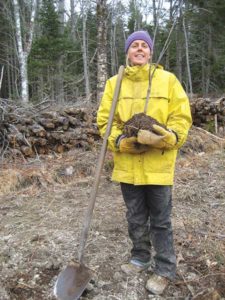 |
| Anneli Carter-Sundqvist gets ready to plant the first apple tree in 2015. Photo by Dennis Carter |
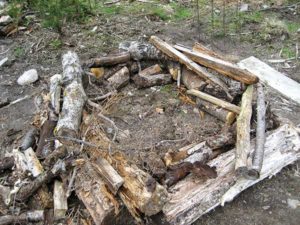 |
| Raised beds were built for each tree using logs and brush left from clearing the land. Photo by Anneli Carter-Sundqvist |
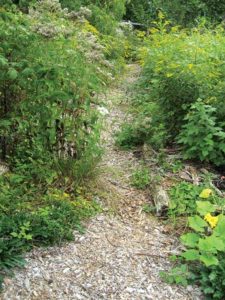 |
| Boneset and goldenrod line the woodchip-mulched paths. Photo by Anneli Carter-Sundqvist |
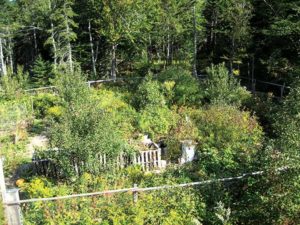 |
| The wild and unfettered orchard at Deer Isle Hostel. Photo by Dennis Carter |
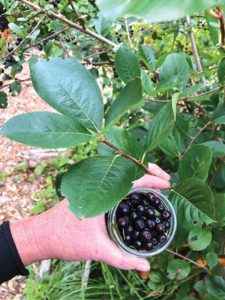 |
| Aronia berries. Photo by Brighid Doherty |
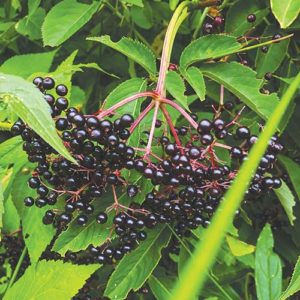 |
| Elderberry in the orchard. Photo by Brighid Doherty |
By Anneli Carter-Sundqvist
In the not too distant past, say 20 years ago, the clearing that is now our homestead at Deer Isle Hostel was almost entirely covered in woods. Over the course of many years my husband Dennis Carter, and later the two of us together, opened up space for our gardens and many outbuildings. Still there was an area behind our main building that I could not wrap my mind around – it was a jumble of fir and white spruce (most of them dead or dying), brambles, rocks and boulders. To transform this piece of land into any kind of cultivated area just seemed so far out of reach that I didn’t even make an attempt.
Then in the fall of 2012 we went to visit to John Bunker and his Super Chilly Farm in Palermo. He had recently cleared an acre of land to make room for an orchard. Instead of creating the quintessential fruit-trees-on-a-well-mowed-lawn, as most of us imagine an orchard to be, he had tossed the logs, stumps and branches resulting from the clearing into big piles, pushed enough shrub and brambles aside and planted the fruit trees right in the middle of it all. Bunker explained to Dennis and me how he often encounters wild apple trees – growing in a thicket of shrubs and wildflowers or surrounded by decaying trees – displaying healthy, disease-free fruit without any human interaction, and definitely no spraying. His idea with this orchard was to mimic those natural habitats: The brush piles and organic matter left in the area serve as fertilizer for all sorts of fungi and microorganisms that will feed the soil and the trees, and the polyculture of insect-attracting plants and flowers help to deter pests and keep diseases at bay. This resonated with our goal to use natural resources around the homestead, making the most of what’s already here. Furthermore, the relatively low labor involved in creating this sort of orchard was something I could conceivably take on. Right then and there I knew exactly what to do with that godforsaken piece of land at home.
Preparing the Land
That winter I started to clear the area, aiming for about 100-by-100 square feet. I wanted to use as many of the living trees as possible for firewood, so the number of trees I could fell each year was limited to what could fit in our woodshed. We stacked the dead wood in a wall at the back of the area and piled the smaller brush in mounds here and there. Throughout this time we also grafted apple trees, keeping them in a nursery in the garden for a couple of years. The grafts were all made onto standard rootstock. We used scionwood from old heirloom varieties, such as Baldwin and Northern Spy, and from wild apple trees from around the island that bear fruit which we have picked and enjoyed for years.
The spring that we were ready to plant our orchard, we realized that the area was wetter than we thought and would require the digging of some substantial drainage. We enlisted a friend with a small excavator but had to wait until the ground was dry, pushing the planting date forward until the next spring. We gave that year’s tree seedlings away and waited patiently until the following year. This was a very good experience: It is worth doing it right even if it means postponing planting. A year or two is a very short time in the context of how long a well-established, healthy tree can live. It is surely less frustrating in the long run to wait for better conditions, rather than planting and tending a tree that will suffer from bad circumstances.
Planting the Trees
In 2015 we were finally ready to plant. We planted nine apple trees in a grid; each tree was 25 feet apart. Since the soil was so wet, even with the extra drainage provided by the ditches, I used logs and branches from the area to build a 3-by-3-foot, 12-inch-high raised bed around each planting site. I filled each bed with a mix of soil and compost.
In this way most of the apple trees’ roots were above the wettest ground until they became established. Over the years we mounded seaweed and compost onto these heaps, and now the log-and-branch frames are almost entirely broken down – serving a dual purpose as fertilizer for the trees. In the beginning we did not fence in the cleared area but encircled each tree with concrete wire mesh to protect them from deer. When combined, two sheets of 5-by-10-foot mesh make a circle that is roughly 7 feet in diameter – big enough for the tree to grow within for a few years. The sheets are held together by heavy wire, and the circle is held in place by simply putting four bricks at even spacing along the base.
Between the apple trees we planted peach trees; those will yield early and likely diminish before the apple trees are big enough to compete for the space. I made paths, mulched with woodchips, so that we can easily move a wheelbarrow to every corner of the orchard.
The orchard is also where we have our compost piles for our humanure sawdust toilets. Since the outhouses are in close proximity to the orchard and the fruit trees are where the compost will eventually end up, this location cuts out excessive moving of material.
Eventually I found the time to build a fence around the entire orchard. We used cedar posts and 6-foot-tall chicken fencing. Keeping the deer out was necessary in order to plant things that could not be individually fenced and to utilize the entire space. We wanted to seize the opportunity to grow an orchard Bunker-style, just like at Super Chilly Farm, and plant more than just fruit trees.
Diversity in the Orchard
My aim for the work I do on our homestead is for it to have a positive impact; my goal is to leave this place better than I found it. As I mentioned, this parcel was but a mess of fir and spruce, with nothing exciting as understory and almost nothing to feed pollinators. By opening up the parcel to sunlight and adding natural amendments such as wood ash, seaweed and compost, all while encouraging fungi and microorganisms by leaving wood debris to rot in place, we now have an incredible gamut of flora and fauna growing in the orchard.
Most of the flowers now present I did not introduce, including goldenrod, tansy, violet, mullein and boneset. Some of them, like the tansy and the boneset, did not even grow on our homestead before we planted the orchard. Other plants, including anise hyssop and lemon balm, jumped the fence from our garden where I had once planted them. All of these plants come with perks – they attract beneficial insects and some are edible and/or medicinal, and, not to be overlooked, all of them they are beautiful.
I also planted berry shrubs like currant, elderberry and chokeberry (Aronia melanocarpa). Without waiting to be asked, the blackberries and raspberries invited themselves – as they tend to do. These shrubs are full of pollinators at blooming time, and I picked gallons of berries within a few years. For better or worse, these berry shrubs are also quite the bird-feeding station for summer residents and year-rounders alike.
In 2020 we cleared the remaining brambles and shrubby birches and firs from the untouched part of this space and established garden beds. And in the fall we added potatoes, beans and squash to the growing list of goods coming from the orchard.
Even though we did get our first few precious apples in 2019, it will be a while before we see a substantial yield. But even through these years of waiting, the land provides for us – thanks to this unfettered approach to what an orchard can be.
Annual Maintenance
Because our goal is to keep this orchard wild and natural, the amount of maintenance is very low (other than in the garden patch we added this year). Every spring I weed around the trees and shrubs and top-dress each with a generous wheelbarrow’s worth of 2-year-old compost, as well as a good helping of seaweed that we harvest from the shore.
A couple of times each year I weed the paths and also cut down any brambles that are getting in the way of walking or are starting to encroach upon the fruit trees or berry shrubs.
The fruit trees are still young, so the pruning is light. Mostly, for the last couple of years, it has been a matter of cutting out the nests of browntail moths which have become endemic in our area. The only disease we have experienced so far is leaf curl on our peaches, for which we do a fall spraying of organically approved neem oil.
One of the worst pests for the apple grower is the round-headed apple borer that digs under the bark at the bottom of the trunk and, if not stopped, can girdle and even kill a pretty good-sized tree. One of Bunker’s observations of apple trees growing in the wild is that they are host to a very low number of apple borers – as if the polyculture and thick understory somehow deter the pest. Whether or not that is the case for us, in all these years we have found a total of three borers.
Passing on the Torch
An apple orchard can be about so much more than apples. There is a lot to glean from this kind of endeavor – not only in terms of pints or gallons or bushels but also in terms of health, vigor, natural abundance and beauty. By carefully interfering with nature we have turned a woodlot with a very limited range of life into an Eden for countless lifeforms. We couldn’t even walk through the area a few years ago, and now when I go out there in the evenings to get my fill of peaches, Asian pears or berries, I’m struck speechless by the buzzing of pollinators, the singing of birds and the scent of so many wildflowers.
Our guests at Deer Isle Hostel venture out there, too, and we offer tours to many visitors through the thick stands of brambles and goldenrod every summer. Hopefully, we can pass on the torch we were handed from Bunker that fall day many years ago, and someone will return to their land and see past what is first apparent, recognizing the possibilities that may hide there. Growing an orchard is less about growing fruit when compared to the magnitude of working with nature to create a landscape that will not only benefit itself but also everything that is in it.
About the author: Anneli Carter-Sundqvist grew up in the north of Sweden and came to Maine in 2008. She is the co-founder and manager of Deer Isle Hostel and the author of “A Homesteader’s Year on Deer Isle” (self-published, 2014). See https://deerislehostel.wordpress.com/ for more information.
